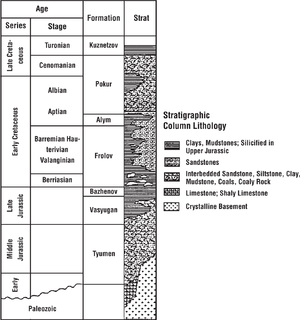Oil correlation case history: West Siberian basin
| Exploring for Oil and Gas Traps | |

| |
| Series | Treatise in Petroleum Geology |
|---|---|
| Part | Critical elements of the petroleum system |
| Chapter | Oil–oil and oil–source rock correlations |
| Author | Douglas W. Waples, Joseph A. Curiale |
| Link | Web page |
| Store | AAPG Store |
Several Russian geoscientists as well as geochemists in the United States and Europe have addressed the question of the source(s) of oils in the prolific West Siberian basin. Peters et al.[1] present the results of a fully integrated [[oil–oil and oil–source rock correlation]] study involving numerous oils and possible source rocks in the basin. This case study examines the relationship between one of the West Siberian Basin oil families and its suggested source rock.
Geological setting
The West Siberian basin, located in central Russia, is approximately bisected north–south by the Ob River. Figure 1 is a stratigraphic section of the basin. Oils are reservoired throughout the section but are concentrated in the Lower Cretaceous and Upper Jurassic.
Correlation process
Peters et al.[1] examined 32 oil samples from this region, using a full assortment of elemental (sulfur), isotopic (δ13C of whole oil), and molecular data (biomarkers). In addition, source-based cluster analysis using sterane and diasterane distributions, tricyclic terpane distributions, and carbon isotope ratios was used to group the oils and prospective source rocks.
Peters et al.[1] approached both the oil–oil and oil–source rock correlation aspects together, relying upon molecular and isotopic data accompanied by cluster analysis results. The distributions of regular steranes and monoaromatic steroid hydrocarbons (C27– C29) provided an excellent framework for the correlation. The oils (shown as solid circles in the figure below) form two distinct families according to these criteria: 26 oils fall in a group relatively depleted in the C29 homolog, while six oils form a group relatively enriched in C29. This two-family oil–oil classification is also consistent with whole-oil carbon isotope ratios as well as with other biomarker data.
The ternary diagrams in Figure 2 show the distribution of the C27–C29 regular steranes (left) and monoaromatic steroid hydrocarbons (right) for oils in the West Siberian basin. Two oil families can be distinguished on the basis of their relative amounts of the C29 homologs. The bitumens from all the Bazhenov Formation rock samples plot together with a single oil family. Molecular structures are shown for the compounds used in the ternary diagrams.
Several possible source rocks in the basin show steroid carbon-number distributions similar to those of one of the oil families in Figure 2. In particular, all the Bazhenov Formation samples (uppermost Jurassic) plot adjacent to the oil family that is relatively lean in the C29 homolog. Other rock samples that also plot with this family in these ternary diagrams do not show valid oil-source correlations using other biomarker and isotope parameters.

Further support for a Bazhenov source is provided by the distribution of extended hopanes. As indicated in the figure below, the “Bazhenov” oils have extended hopane distributions virtually identical with the Bazhenov source rock extracts (indicated as bitumens in the figure). This positive correlation is strengthened because the homohopane distributions are somewhat unusual; thus, the similarity is unlikely to be fortuitous.
Figure 3 shows that distributions of homohopanes by carbon number (C31–C35) for bitumens from the Bazhenov Formation are essentially identical to those for the low-C29-sterane oil family.
What this case study indicates
The conclusion of Peters et al.[1]) that the “low-C29” oils are most likely sourced from the Bazhenov Formation is based upon isotopic and molecular data that are unaffected by maturity and alteration differences that the oils suffered after leaving the Bazhenov source rock. These changes caused variations in sulfur concentrations from less than 0.5% to greater than 2.0%. This case study emphasizes the importance of using source-distinctive biomarker and isotopic data to see through the changes wrought by differences in oil maturity and in-reservoir alteration.
See also
References
- ↑ 1.0 1.1 1.2 1.3 Peters, K., E., Moldowan, J., M., Kontorovich, A., E., Huizinga, B., J., Moldowan, J., M., Lee, C., Y., 1994, Multiple oil families in the West Siberian basin: AAPG Bulletin, vol. 78, p. 893–909.

